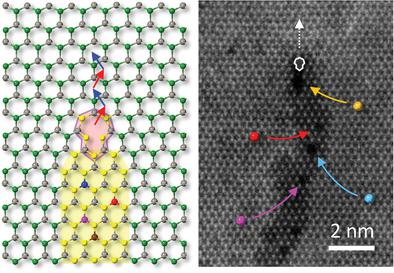当前位置:
X-MOL 学术
›
Adv. Mater.
›
论文详情
Our official English website, www.x-mol.net, welcomes your
feedback! (Note: you will need to create a separate account there.)
Formation of Highly Doped Nanostripes in 2D Transition Metal Dichalcogenides via a Dislocation Climb Mechanism
Advanced Materials ( IF 27.4 ) Pub Date : 2021-02-19 , DOI: 10.1002/adma.202007819 Yung‐Chang Lin, Jeyakumar Karthikeyan, Yao‐Pang Chang, Shisheng Li, Silvan Kretschmer, Hannu‐Pekka Komsa, Po‐Wen Chiu, Arkady V. Krasheninnikov, Kazu Suenaga
Advanced Materials ( IF 27.4 ) Pub Date : 2021-02-19 , DOI: 10.1002/adma.202007819 Yung‐Chang Lin, Jeyakumar Karthikeyan, Yao‐Pang Chang, Shisheng Li, Silvan Kretschmer, Hannu‐Pekka Komsa, Po‐Wen Chiu, Arkady V. Krasheninnikov, Kazu Suenaga

|
Doping of materials beyond the dopant solubility limit remains a challenge, especially when spatially nonuniform doping is required. In 2D materials with a high surface‐to‐volume ratio, such as transition metal dichalcogenides, various post‐synthesis approaches to doping have been demonstrated, but full control over spatial distribution of dopants remains a challenge. A post‐growth doping of single layers of WSe2 is performed by adding transition metal (TM) atoms in a two‐step process, which includes annealing followed by deposition of dopants together with Se or S. The Ti, V, Cr, and Fe impurities at W sites are identified by using transmission electron microscopy and electron energy loss spectroscopy. Remarkably, an extremely high density (6.4–15%) of various types of impurity atoms is achieved. The dopants are revealed to be largely confined within nanostripes embedded in the otherwise pristine WSe2. Density functional theory calculations show that the dislocations assist the incorporation of the dopant during their climb and give rise to stripes of TM dopant atoms. This work demonstrates a possible spatially controllable doping strategy to achieve the desired local electronic, magnetic, and optical properties in 2D materials.
中文翻译:

通过位错爬升机制在二维过渡金属二硫属元素化物中形成高掺杂纳米带。
超出掺杂剂溶解度极限的材料掺杂仍然是一个挑战,特别是在需要空间不均匀掺杂的情况下。在具有高表面体积比的2D材料中,例如过渡金属二卤化碳,已经证明了各种合成后的掺杂方法,但是要完全控制掺杂剂的空间分布仍然是一个挑战。WSe 2单层的生长后掺杂通过分两步添加过渡金属(TM)原子来执行,该过程包括退火,然后与Se或S一起沉积掺杂剂。W位置的Ti,V,Cr和Fe杂质通过透射电子来识别显微镜和电子能量损失谱。值得注意的是,各种杂质原子的密度都非常高(6.4-15%)。据发现,掺杂剂主要局限在嵌入原本为WSE 2的纳米带内。密度泛函理论计算表明,位错在掺杂剂的爬升过程中有助于掺入并引起TM掺杂剂原子的条纹。这项工作演示了一种可能的空间可控掺杂策略,可以在2D材料中实现所需的局部电子,磁性和光学特性。
更新日期:2021-03-23
中文翻译:

通过位错爬升机制在二维过渡金属二硫属元素化物中形成高掺杂纳米带。
超出掺杂剂溶解度极限的材料掺杂仍然是一个挑战,特别是在需要空间不均匀掺杂的情况下。在具有高表面体积比的2D材料中,例如过渡金属二卤化碳,已经证明了各种合成后的掺杂方法,但是要完全控制掺杂剂的空间分布仍然是一个挑战。WSe 2单层的生长后掺杂通过分两步添加过渡金属(TM)原子来执行,该过程包括退火,然后与Se或S一起沉积掺杂剂。W位置的Ti,V,Cr和Fe杂质通过透射电子来识别显微镜和电子能量损失谱。值得注意的是,各种杂质原子的密度都非常高(6.4-15%)。据发现,掺杂剂主要局限在嵌入原本为WSE 2的纳米带内。密度泛函理论计算表明,位错在掺杂剂的爬升过程中有助于掺入并引起TM掺杂剂原子的条纹。这项工作演示了一种可能的空间可控掺杂策略,可以在2D材料中实现所需的局部电子,磁性和光学特性。











































 京公网安备 11010802027423号
京公网安备 11010802027423号